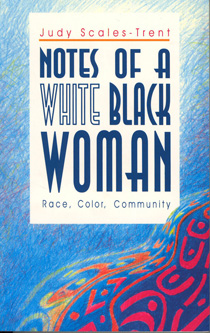Notes of a White Black Woman: Race, Color, Community
Penn State Press
1995
206 pages
6 x 9
cloth: ISBN 978-0-271-01430-2
paper: ISBN 978-0-271-02124-9
Judy Scales-Trent, Floyd H. & Hilda L. Hurst Faculty Scholar, Professor Emerita
State Univerisity of New York at Buffalo Law School
“I remember one time in particular, after the cab I was in crashed into the car in front, then backed into the one behind. A policeman stopped to help. As he was taking down my name and address, I noticed that he had checked the ‘white’ box. ‘Officer,’ I said politely, ‘you made an error on your form. I am not white. I am black.’ He gave me a long, bored look, decided not to discuss it, and said, ‘Sure, lady. If you say so.’ If I say so? If I say so! As if it were my idea! I was enraged at his assumption that all of this—the categories, the racial purity laws, the lives that are stomped, mangled, ruined because of those categories and those laws ïwas based on my say-so. If I said so, we would do away with all of it ïthe sickness and fear, the need to classify as a way to control, the need to make some appear smaller so that others can appear larger. ‘If I say so’ indeed.”
While the “one-drop rule” in the United States dictates that people with any African ancestry are black, many black Americans have white skin. Notes of a White Black Woman is one woman’s attempt to describe what it is like to be a “white” black woman and to live simultaneously inside and outside of both white and black communities.
Law professor Judy Scales-Trent begins by describing how our racial purity laws have operated over the past four hundred years. Then, in a series of autobiographical essays, she addresses how race and color interact in relationships between men and women, within families, and in the larger community. Scales-Trent ultimately explores the question of what we really mean by “race” in this country, once it is clear that race is not a tangible reality as reflected through color.
Scales-Trent uses autobiography both as a way to describe these issues and to develop a theory of the social construction of race. She explores how race and color intertwine through black and white families and across generations; how members of both black and white communities work to control group membership; and what happens to relations between black men and women when thelayer of color is placed over the already difficult layer of race. She addresses how one can tell–and whether one can tell–who, indeed, is “black” or “white.” Scales-Trent also celebrates the richness of her bicultural heritage and shows how she has revised her teaching methods to provide her law students with a multicultural education.

Leave a Reply
You must be logged in to post a comment.